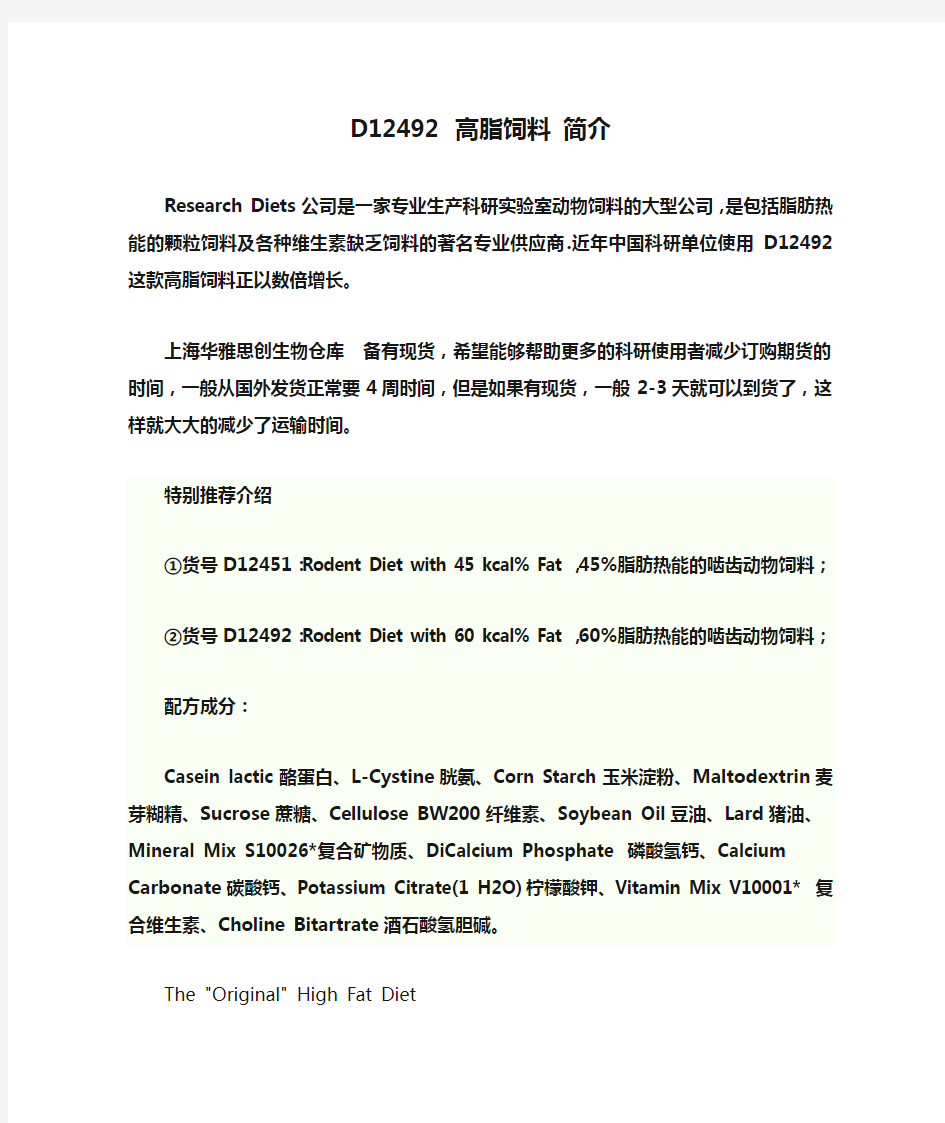D12492 高脂饲料 简介

- 1、下载文档前请自行甄别文档内容的完整性,平台不提供额外的编辑、内容补充、找答案等附加服务。
- 2、"仅部分预览"的文档,不可在线预览部分如存在完整性等问题,可反馈申请退款(可完整预览的文档不适用该条件!)。
- 3、如文档侵犯您的权益,请联系客服反馈,我们会尽快为您处理(人工客服工作时间:9:00-18:30)。
D12492 高脂饲料简介
Research Diets公司是一家专业生产科研实验室动物饲料的大型公司,是包括脂肪热能的颗粒饲料及各种维生素缺乏饲料的著名专业供应商.近年中国科研单位使用D12492这款高脂饲料正以数倍增长。
上海华雅思创生物仓库备有现货,希望能够帮助更多的科研使用者减少订购期货的时间,一般从国外发货正常要4周时间,但是如果有现货,一般2-3天就可以到货了,这样就大大的减少了运输时间。
特别推荐介绍
①货号D12451:Rodent Diet with 45 kcal% Fat,45%脂肪热能的啮齿动物饲料;
②货号D12492:Rodent Diet with 60 kcal% Fat,60%脂肪热能的啮齿动物饲料;配方成分:
Casein lactic酪蛋白、L-Cystine胱氨、Corn Starch玉米淀粉、Maltodextrin麦芽糊精、Sucrose蔗糖、Cellulose BW200纤维素、Soybean Oil 豆油、Lard猪油、Mineral Mix S10026*复合矿物质、DiCalcium Phosphate 磷酸氢钙、Calcium Carbonate碳酸钙、Potassium Citrate(1 H2O)柠檬酸钾、Vitamin Mix V10001* 复合维生素、Choline Bitartrate酒石酸氢胆碱。
The "Original" High Fat Diet
In 1996, a regular customer of Research Diets, Inc. approached Dr. Ulman to help formulate an OpenSource Diet to use in a Diet Induced Obesity (DIO) mouse model. The model was based loosely on published work by (1) Surwit et al.(1995) and (2) West et al. (1995), in which a chow-based, undefined diets were used to study the DIO phenotype in inbred mouse strains. However, the group required a diet with a defined, flexible formulation containing 45 kcal% fat, predominantly lard, and the product needed to be a solid pellet in order to conduct food intake studies. Research Diets, Inc. submitted several preliminary formulas for discussion, and the group settled on D12451 (HFD) and its' control OpenSource Diet, D12450 (LFD).
The publication of the discovery of leptin by (3) Zhang and Friedman et al (1994) created worldwide interest in this novel peptide as a tool for research and therapeutic discovery for obesity and its related disorders. D12451 not only generated the hypothesized phenotype in its
first study, it also helped the investigators discover, research, and describe the leptin resistance phenomenon. The results of this initial study, and the description of the use of these two diets are presented in the paper by (4) Van Heek et al (1997), “Diet induced ob ese mice develop
peripheral, but not central resistance to leptin”.
The D12492 Story
On April 19th 1999, nearly 15 years after Research Diets, Inc. began in Dr. Ed Ulman's kitchen, John Larose made the first 25 kg of D12492 (VHFD). Somehow,
he was able to pellet 12.5 kg of this 60 kcal % high fat diet and on April 22, 1999 the first box of pelleted D12492 was shipped. In 1999 research Diets shipped 150 kg of D12492, and today ship over 10,000 kg of D12492 monthly. Today, there are more DIO rodent models made using our diets than any other diets in the world. This year celebrates the 10th anniversary of D12492.
Worldwide
D12492 has shipped to 1000s of individuals, working at 420 separate institutions in 33 countries (Australia, Belgium, Canada, Chile, China, Colombia, Czech Republic, Denmark, Finland, France, Germany, Hungary, India, Ireland, Israel, Italy, Japan, Mexico, Netherlands, New Zealand, Norway, Poland, Portugal, Scotland, Singapore, South Korea, Spain, Sweden, Switzerland, Turkey, United Kingdom, and United States).
How Many Mice Eat D12492?
Considering D12492 production in terms of mice eating and assuming mice eat 5 gm of D12492/day, 250,000+ kg of D12492 could feed 50 million mice for 1 day. This means that 250,000 or so mice could be observed for 200 days each while eating D12492. With 8000+ kg of D12492 shipping monthly (averaging 265 kg each day) we can estimate that somewhere and everywhere in the world today there are 50,000 mice alive and growing fat while eating our D12492.
What It Means
Observations made with these 50,000 mice can be compared to each other and to the 250,000 or so other mice that already ate D12492 and were observed, recorded and reported by someone, somehow, somewhere, so far.
Over the past 10 years, these diets, have become the standard for research in the field of obesity, diabetes, and metabolic syndrome. Top worldwide breeders CRL, Taconic and JAX, feed D12492 to produce DIO mice for the research community.
A recent search revealed hundreds of publications in which these diets were utilized. By using these standards, investigators are privy to a wide range of reference data from an expanding research publication base.
P.S. D12492 is only 1 of the 14,000 diets we’ve formulated and produced and there’s
more every day.
A Word of Caution Don’t be misled by diet manufacturers who claim to offer the same OpenSource diet formulas as Research Diets, Inc. Though it is true that all our formulas are open, there may be differences in the sources of ingredients or the vitamin and mineral mixes used to produce the diet.There is only one sure way to repeat research based on the "Original" OpenSource Diet formula—go to the source of that formula. There is only one place to get OpenSource Diets and that’s at
